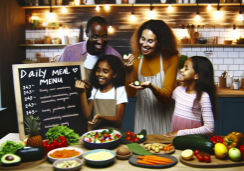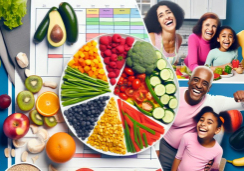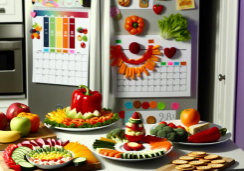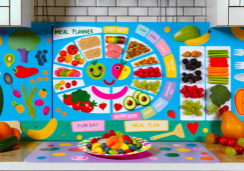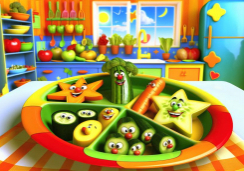Kickstart Your Low-Carb Kitchen Adventure
Imagine your kitchen transforming into a sanctuary where carbs are virtually extinct and every dish is a masterpiece of health and flavor—that's the journey you're about to embark on.
As you stand at the precipice of your low-carb kitchen adventure, you'll find that the path ahead isn't just about subtracting sugars and starches; it's a creative and rewarding culinary exploration. Armed with the right ingredients and a touch of know-how, you'll be whipping up dishes that could dazzle even the most devout carb lovers.
But where do you start, and how do you ensure your pantry supports this new way of eating? Stay with me, and I'll guide you through the essentials to transform your kitchen into the low-carb haven you're envisioning, where every meal is a step towards a healthier you.
Assessing Your Pantry Staples
To successfully embark on your low-carb journey, it's essential to first evaluate your pantry, identifying staples like nuts and seeds while swapping out high-carb items for healthier alternatives. Your diet is about to undergo a transformation, and that starts with a carb-conscious environment at home. You'll want to keep an eye out for grains, starchy foods, and sugary snacks. These are the culprits that can disrupt your low-carb meal plan today. Instead, stock up on low-carb alternatives such as almond flour and coconut flour, alongside sugar substitutes to maintain unlimited flavor.
The complete vegetarian might wonder how to keep meals interesting without the carbs. Enter the 'Low-Carb Vegetarian Cookbook,' your guide to diverse and delicious eating. Consider adding it to your library for inspiration. Don't overlook fresh produce, which should be a cornerstone of your meal plan. Explore a sample two-week menu to get a sense of how to incorporate a variety of veggies and fruits.
Plan today and start your low-carb diet off right by organizing your pantry. Ensure that everything is within reach and that you eat lots of oh-so-important fresh ingredients. Remember, this isn't just about cutting out carbs; it's about embracing a healthy, balanced lifestyle.
Essential Low-Carb Ingredients
Stocking your kitchen with essential low-carb ingredients is a pivotal step in crafting nutritious and satisfying meals on a ketogenic diet. This includes quality meats, fresh seafood, and a variety of non-starchy vegetables. Focusing on these high-fat, low-carb options ensures that you're preparing meals that align with your carb-conscious goals.
When it comes to essential cooking on this diet, healthy fats such as olive oil, coconut oil, and avocados are key. They're not only flavorful but also provide the energy your body needs. Nuts and seeds are great for snacking and adding crunch to your dishes without the carbs.
If you're veering towards a plant-based approach, a creative vegetarian cookbook will help you find delicious recipes that cater to low-carb eaters. Savory Mushroom Risotto is just one example of the many plant-based twists you can explore with the help of a vegetarian cookbook.
To ensure you're on track, it's crucial to avoid high-carb foods like sugar, grains, and legumes. Instead, get convenient, time-saving advice and simple strategies for satisfying meals. Explore a sample two-week meal plan, and remember to stay hydrated and monitor your macros. Diet tips like these are the foundation of a successful low-carb kitchen.
And don't forget, support from a low-carb community can be invaluable as you embark on this adventure.
Planning Your First Week's Menu
Having established the essential low-carb ingredients for your kitchen, it's time to map out your first week's menu with delicious and nutritious meals that adhere to your dietary goals. You'll want to start eating smarter by planning simple yet satisfying meals that help you feel full and lose weight without sacrificing taste or variety. Here's how you can kick-start your culinary adventure:
- Kick-Start Meal Plan
- *Breakfast:* Begin with low-carb options for breakfast like a fulfilling Avocado Almond Toast from your Vegetarian Cookbook: 100 Easy Recipes.
- *Lunch:* Prepare meals in minutes with hearty vegetarian cookbook recipes like a Savory Cheesecake that's rich in flavor and nutrients.
- *Dinner:* Conclude your day with a dish that combines protein and vegetables, ensuring you lose weight while serving up satisfaction.
To start eating smarter, ensure your meal plan includes a balance of essential nutrients and adheres to your dietary requirements. Incorporate advice and simple strategies such as batch cooking or meal prepping to save time. By doing so, you'll have healthy options readily available and can enjoy your meals without the stress of daily cooking.
Remember to make a list of all the necessary ingredients for your meals and do a thorough grocery shopping trip to set yourself up for success.
Shopping Tips for Low-Carb Diets
Embark on your low-carb journey with confidence by mastering the art of grocery shopping, ensuring your cart is filled with foods that support your dietary goals. When you're aiming to lose weight or maintain a low-carb lifestyle, understanding which foods to prioritize is crucial.
Start by selecting fresh vegetables and leafy greens, the staples of low-carb options, that will provide you with essential nutrients and fiber.
Lean into lean cuts of meat and poultry to kick-start your low-carb meal plan with high-quality proteins. For the carb-conscious, integrating healthy fats such as avocados, olive oil, and nuts into your diet can be beneficial, not only for satiety but also for overall health.
If you're vegetarian, don't fret. The 'Vegetarian Cookbook: 100 Easy Recipes' offers an array of meals that align with low-carb principles. Imagine indulging in recipes like Avocado Almond without derailing your dietary objectives.
Prepping Meals for Success
After mastering the art of grocery shopping for low-carb ingredients, it's essential to focus on prepping meals that will keep you aligned with your dietary goals. Planning is key; by knowing what you'll eat in advance, you can manage your carb intake and resist impulsive choices.
Here's how to prep for success:
- Plan Your Kick-Start Meal
- Use a cookbook that will help guide your meal prep journey.
- Select recipes that feel full and lose no flavor, such as hearty vegetarian delights.
- Batch Cooking
- Cook scrumptious veggie dishes in larger quantities.
- Store in portioned containers for easy access throughout the week.
Incorporating a variety of recipes in your plan will ensure you're never bored. Your cookbook can become your best friend, serving up scrumptious veggie dishes that make your low-carb journey enjoyable. Remember, the goal is to feel full and lose weight, if that's your aim, without sacrificing taste.
Batch cooking and storing meals can kick-start your week positively, setting you up for success. Freezing extra portions means you've got a backup when time is tight. And when those carb cravings hit, having a fridge stocked with low-carb, high-flavor meals means delights abound.
Frequently Asked Questions
What Happens the First Two Weeks of Low-Carb Diet?
You'll likely experience carb withdrawal symptoms, energy fluctuations, and mood swings. Weight loss often occurs, alongside appetite changes and sugar cravings. Prioritize meal planning, hydration, and a nutrient focus to manage digestive adjustments.
Does a 16 Hour Fast Put You in Ketosis?
You'll find that a 16-hour fast can induce ketosis by depleting glycogen and shifting metabolism toward fat adaptation, improving insulin sensitivity, and enhancing hormonal balance, which may increase energy and aid hunger management.
Will a 24 Hour Fast Start Ketosis?
Yes, a 24-hour fast can initiate ketosis by causing a metabolic shift. However, energy levels, hunger management, and electrolyte balance must be monitored, as fasting benefits vary due to ketosis misconceptions and individual carb withdrawal.
What Foods Get You Into Ketosis Fast?
To enter ketosis quickly, focus on nutrient-dense snacks, high-fat recipes, and meals planned with low vegetable carb counts. Consider MCT oil usage, coconut oil benefits, and manage electrolytes with dairy-free options.
Conclusion
You've now equipped yourself with the tools for keto success. Remember, revamping your pantry with low-carb staples and planning your meals are pivotal steps.
Be savvy while shopping—opt for whole, nutrient-dense foods. With Gigi's guidance and your new skills, you're set to craft delicious keto dishes.
Stay committed to your low-carb journey, and watch as your kitchen becomes a haven for healthy, sumptuous meals.
Embrace the change, and enjoy your culinary adventure!



